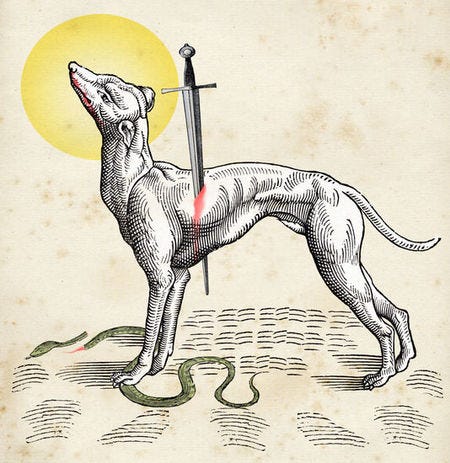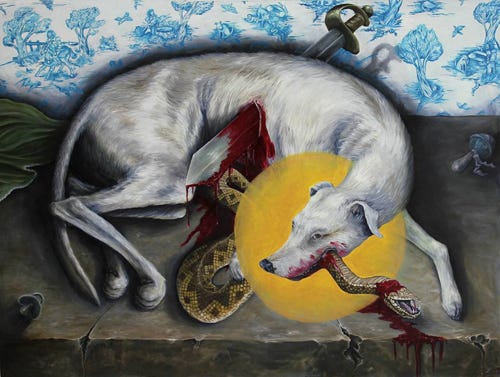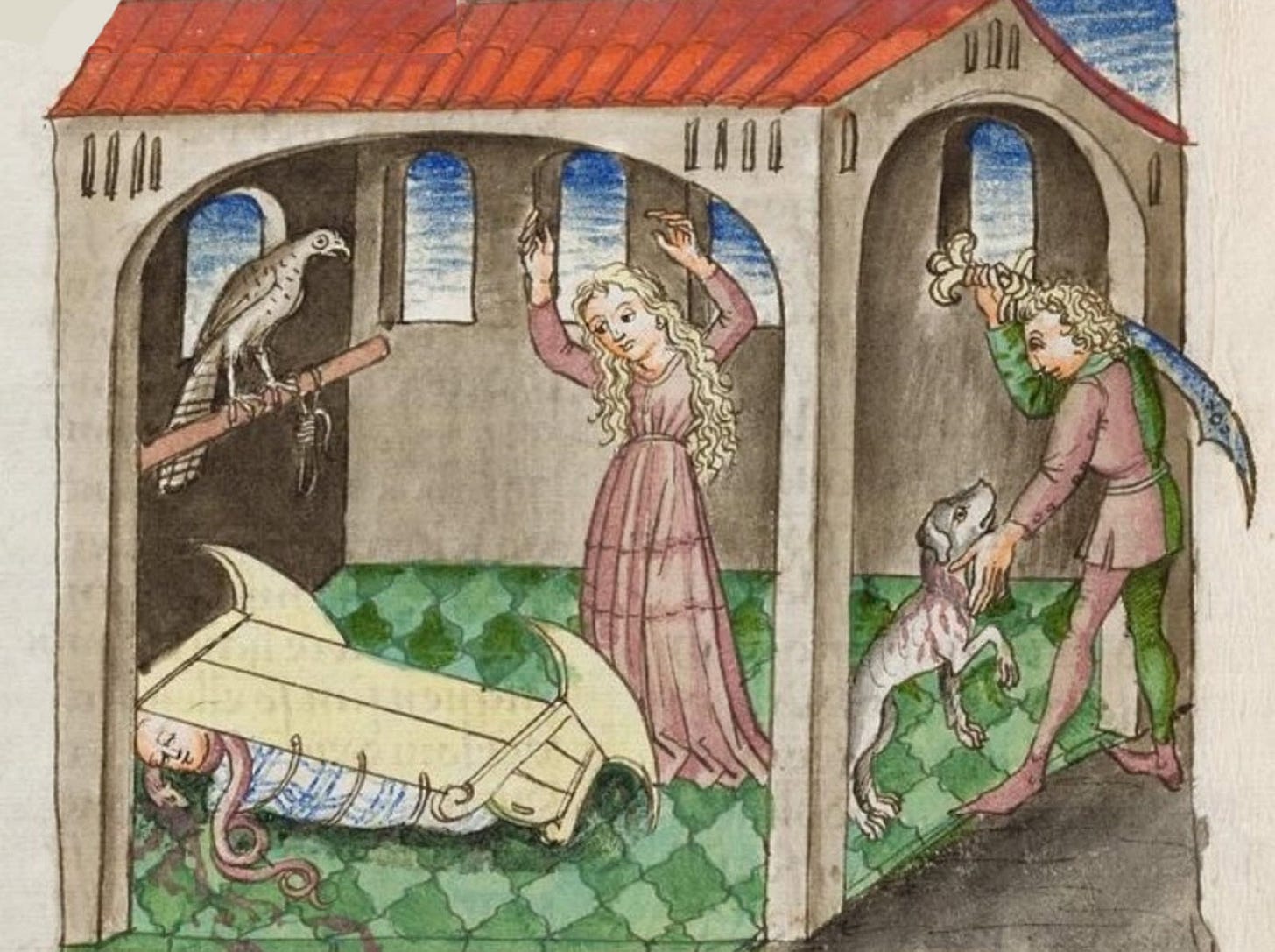Dear readers,
It is a Sunday afternoon. I am at home, hanging out with my dear and good dog, Teddy. Together, we are deep in the weeds reading about Saint Guinefort, of France. Guinefort was a loyal but tragically misunderstood dog who became the patron saint of sick children.

The story of this French folk saint1 was recorded by Etienne de Bourbon2, a thirteenth-century Dominican friar, historian and preacher. Etienne was one of the many Franciscan and Dominican friars that Pope Gregory IX sent out, following his persecution of the Cathars and Waldensians, to ensure that the inquisition had, in fact, eradicated heresy throughout France (as well as Italy and Germany). During his travels, he passed through Lyons, which is where he heard, and later recorded, the tale of Saint Guinefort.
Stephen’s rendering of Guinefort’s tale is concise, engaging, and superbly weird (by which I mean, both hauntingly simply told, and an eerie reminder of how strange the past so often was). Though I’d love to retell it for you, it is well worth reading in (a translation from) the original. Here it is, in its entirety, as recorded in his De Supersticione: On St. Guinefort3:
When preaching [in Lyons] against sorcery and hearing confessions, I heard many women confess that they had carried their children to Saint Guinefort. I thought he was some saint. I made inquiries and at last heard that he was a certain greyhound killed in the following way. In the diocese of Lyons, close to the villa of the nuns called Villeneuve, on the land belonging to the lord of Villars-en-Dombe, there was a certain castle whose lord had a baby son from his wife. But when the lord and lady and the nurse too had left the house, leaving the child alone in his cradle, a very large snake entered the house and made for the child’s cradle. The greyhound, who had remained there, saw this, dashed swiftly under the cradle in pursuit, knocking it over, and attacked the snake with its fangs, answering bite with bite. In the end the dog killed it and threw it far away from the child’s cradle, which he left all bloodied, as was his mouth and head, with the snake’s blood, and stood there by the cradle all beaten about by the snake. When the nurse came back and saw this, she thought the child had been killed and eaten by the dog and so gave out an almighty scream. The child’s mother heard this, rushed in, saw and thought the same and she too screamed. Then the knight similarly once he got there believed the same, and drawing his sword killed the dog. Only then did they approach the child and find him unharmed, sleeping sweetly in fact. On further investigation, they discovered the snake torn up by the dog’s bites and dead. Now that they had learned the truth of the matter, they were embarrassed (dolentes) that they had so unjustly killed a dog so useful to them and threw his body into a well in front of the castle gate and, placing over it a very large heap of stones, they planted trees nearby as a memorial of the deed.
But the castle was in due course destroyed by divine will, and the land reduced to a desert abandoned by its inhabitants. The local peasants, hearing of the dog’s noble deed and innocent death, began to visit the place and honour the dog as a martyr in quest of help for their sicknesses and other needs. They were seduced and often cheated by the Devil so that he might in this way lead men into error. Women especially, with sick or poorly children, carried them to the place, and went off a league to another nearby castle where an old woman could teach them a ritual for making offerings and invocations to the demons and lead them to the right spot. When they got there, they offered salt and certain other things, hung the child’s little clothes on the bramble bushes around, fixing them on the thorns. They then put the naked baby through the opening between the trunks of two trees, the mother standing on one side and throwing her child nine times to the old woman on the other side, while invoking the demons to adjure the fauns in the wood of “Rimite” to take the sick and failing child which they said belonged to them (the fauns) and return to them their own child: big, plump, live and healthy. Once this was done, the killer mothers took the baby and placed it naked at the foot of the tree on the straws of a cradle, lit at both ends two candles a thumbs-breadth thick with fire they had brought with them and fastened them on the trunk above. Then, while the candles were consumed, they went far enough away that they could neither hear nor see the child. In this way the burning candles burned up and killed a number of babies, as we have heard from others in the same place.
One woman told me that after she had invoked the fauns and left, she saw a wolf leaving the wood and going to the child and the wolf (or the devil in wolf’s form, so she said) would have devoured it had she not been moved by her maternal feelings and prevented it. On the other hand, if when they returned they found the child alive, they picked it up and carried it to a swiftly flowing river nearby, called the Chalaronne [tributary of the Saône], and immersed it nine times, to the point where if it escaped dying on the spot or soon after, it must have had very tough innards.
We went to the place and assembled the people and preached against the practice. We then had the dead dog dug up and the grove of trees cut down and burned along with the dog’s bones. Then we had an edict enacted by the lords of the land threatening the spoliation and fining of any people who gathered there for such a purpose in future.
Guinefort’s story is very similar to another legend, about the wolfhound Gelert—long associated with the Welsh village of Beddgelert (Gelert's Grave)—as well as a tale about another faithful mongoose, from the Panchatantra (the mongoose tale is also recorded in the Hitopadesha, and the Kathasaritsagara). These tales each follow the pattern of ATU178 The faithful animal rashly killed.
In case you wish to celebrate it, the feast of Saint Guinefort takes place each year on the 22nd of August. Can I suggest you refrain from throwing any babies you have handy through a hedge nine times, even if you do suspect they are changelings, substituted for your own children by the fauns of the woods, and instead take a walk in a park, preferably with a very good and loyal dog.
While you are enjoying a picnic (make sure to pack boiled eggs, to be eaten with small twists of salt: my favourite picnic snack!) watch out for snakes, and Dominican friars. Remember to offer your canine companion a delicious snack, and to raise a glass to toast Saint Guinefort with the traditional adage:
Saint Guinefort, Saint Guinefort! Pour la vie, pour la mort!
This newsletter is still evolving. For now, my intention is to publish essays across a broad range of themes: life, love, writing, reading, the natural world, folklore, fairy tales, and so on. If you can afford to do so, I would be enormously grateful if you sponsored my writing by taking up a paid subscription.
If you have constructive feedback to offer, particularly in terms of things you’d like me to write about, or write more about, please let me know by posting in the comments. Also, if you have questions you’d like me to explore or even attempt—in my ever-ambling way—to answer, I’d love to hear them.
Thank you for reading!
Folk saint: one recognised and celebrated informally, by the ‘folk’, rather than one canonised as a saint by the Catholic church.
Etienne’s name is often rendered as ‘Stephen’ in English-language translations of his works.
The tale provided here is a slightly edited extract from Hassal, Paul, ed, "De Supersticione: On St. Guinefort". You can read the full extract online here.








This is one story I'm glad Disney made a happier ending for in Lady and the Tramp!
What an interesting post. This tale of Saint Guinefort is so intriguing. And the second portion of the tale is such a detailed (and distressing!) changeling test.